While studying physics, there will be many laws and equations you’ll come across. These laws form the base of all the theories made by the great physicists. One such important law that each student should know is the series of Newton’s law of motion. The series of laws extends up to three laws with their universal equations, definition, and examples. These laws help us in understanding how objects behave when they are at rest or when they’re in motion when forces act upon them. In this guide, you’ll learn the different laws of motion by sir Issac Newton with various examples to support the statement.
Also read:-
Brief History of Newton’s Laws of Motion
To go back in time, the first law of motion appeared in Newton’s masterpiece called Principia. It all started in 1543 when Nicolaus Copernicus suggested that the sun rather than earth might be the centre of the entire universe. Later to that, scientists such as Galileo, Kepler, and Descartes laid the foundation of new science and explained the workings of a heliocentric universe. In that process, he developed his three laws of motion and explained the shapes of the planets to be ellipses rather than circles. This making of the laws extends between the explanations by Copernicus to Newton and is known as the scientific revolution. In recent years, Newton’s laws were then replaced by quantum mechanics and relativity to be the most fundamental laws of physics.
Newton’s First Law of Motion
Let’s start with the first law of motion by Issac Newton. This law applies to the inability of the things to start motion, come to rest or to change direction. To initiate any of the states requires some external force to cause the change. This property of the massive bodies to resist changes in their current state of motion is known as inertia. So, Newton’s first law of motion is also known as the law of inertia. Here is the statement for the 1st law of motion. Galileo Galilei first formulated the law and later was generalized by Rene Descartes.
“Newton’s 1st law of motion states that a body at rest or uniform motion will continue to be at rest or uniform motion, until and unless a net external force acts on it.”
For example:-
When a basketball player shoots a jump shot, the ball always follows an arcing path. The ball follows this path because its motion obeys Sir Isaac Newton’s laws of motion.
Important note:
If there is no net force resulting from unbalanced forces acting on an object, then the object will continue to maintain a constant velocity. On the contrary, if the velocity is zero, the object remains at rest. More so, if an additional external force is applied, the velocity will change because of the force.
Newton’s Second Law of Motion
The second law of motion by sir Issac Newton describes the state of a massive body when upon by an external force. This law of motion states that the force acting on the body is equal to the product of its mass and acceleration.
“Newton’s 2nd law of motion states that the acceleration of an object as produced by a net force is directly proportional to the magnitude of the net force, in the same direction of the net force applied and inversely proportional to the mass of the object.”
It states the intensity of acceleration as performed by a given net force.
The mathematical derivation of the law of motion can be expressed as:-
F∝ dP \ dt
f∝ mv−mu \ t
F∝ m(v−u)t
F∝ma
f=kma
In this equation, k represents the constant of proportionality, which is equal to 1, on taking the values in SI unit. Hence, the final equation is f = ma.
For example:
Riding a bicycle: In this, e.g., your bicycle is the mass, your leg muscles pushing on the pedals is the force. When you push on the pedals, your bicycle starts to accelerate. The increase in the speed of the bicycle takes place when you apply force on the pedals.
Newton’s Third Law of Motion
The 3rd law of motion describes the change in the state of the body when being exerted upon by another body.
“According to the 3rd law of motion, every action, there is always an equal and opposite reaction.”
When two bodies interact with each other, they tend to apply a force on each other that is equal in magnitude and opposite in direction. Also, this law implies the conservation of momentum.
For example:-
When a book rests on the table, its weight applies force on the table, and the table, in turn, exerts an equal and opposite force on the book. Thus, due to equal and opposite force, it tends to rest on the table.
For more such physics-related topics, seek instant online assignment help from us. We have physics experts who can provide you with 24*7 assistance. Chat with us now!
Related Questions
The Qin Emperor not only unified China but also accomplished everything


